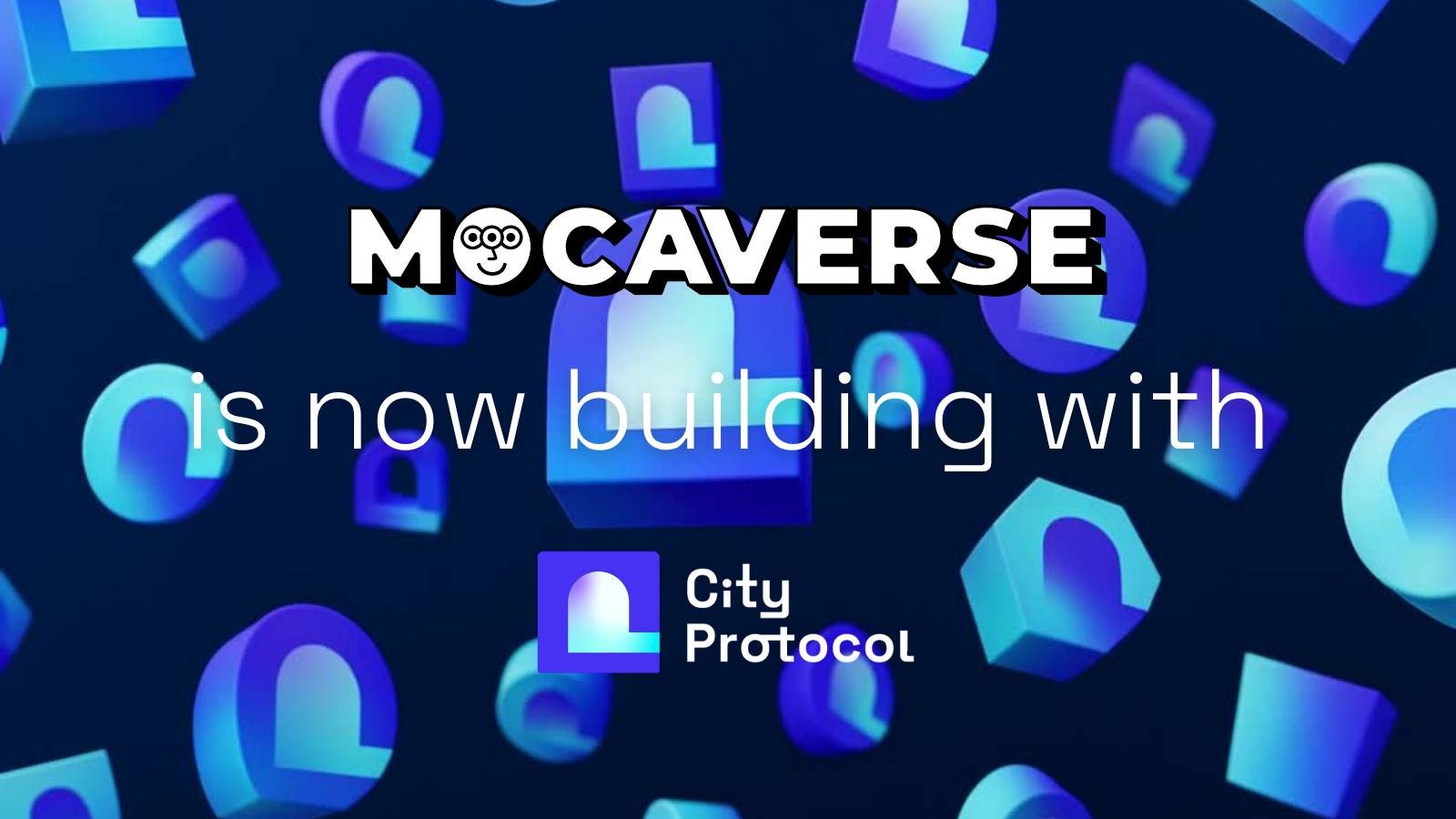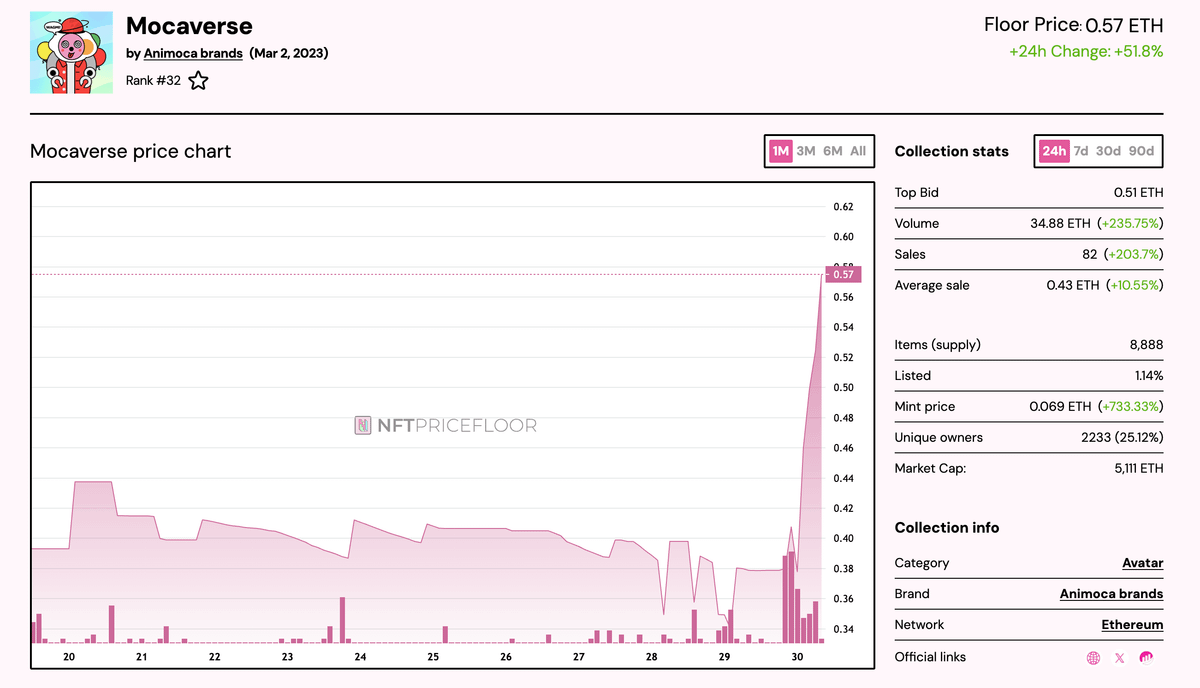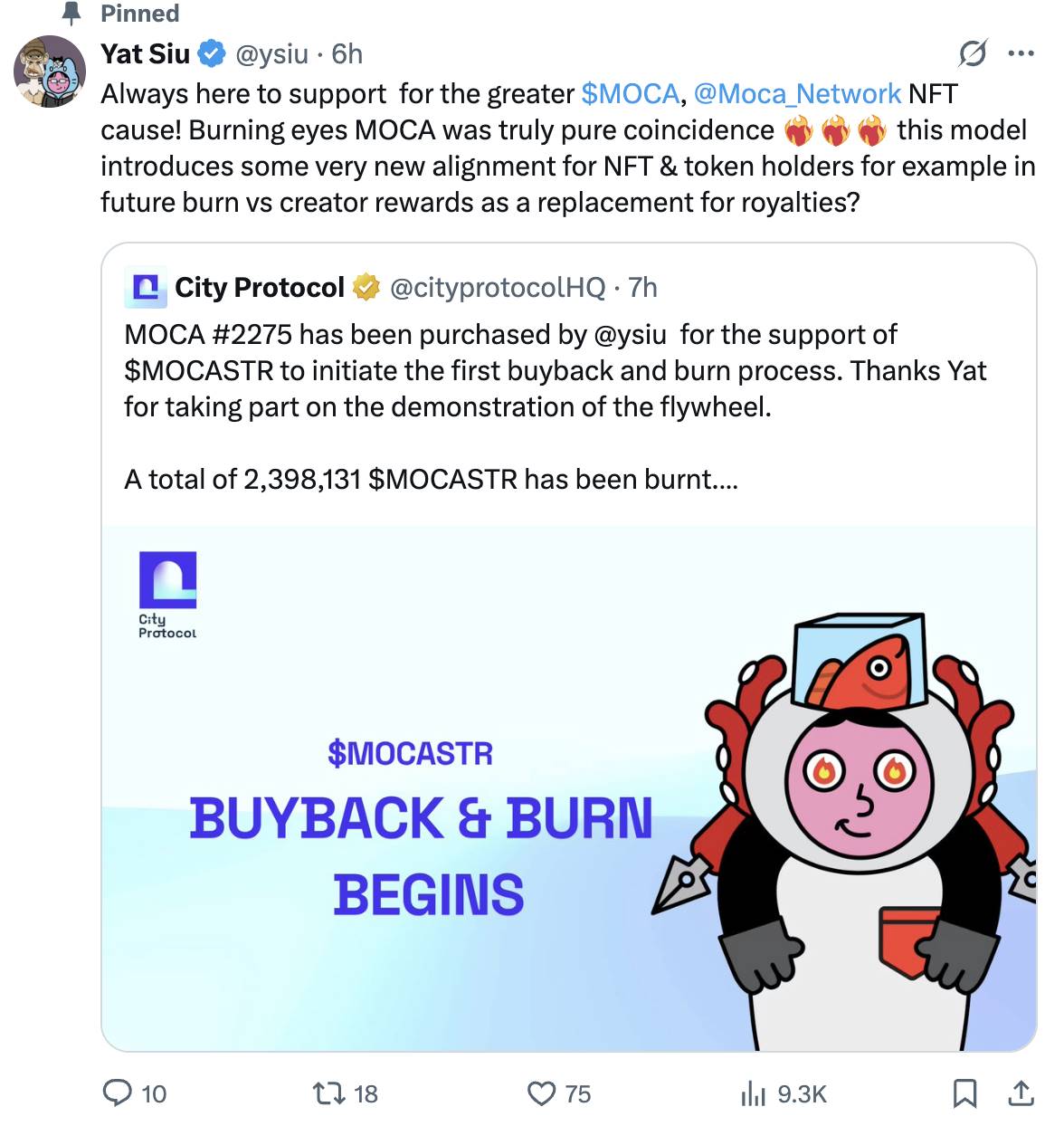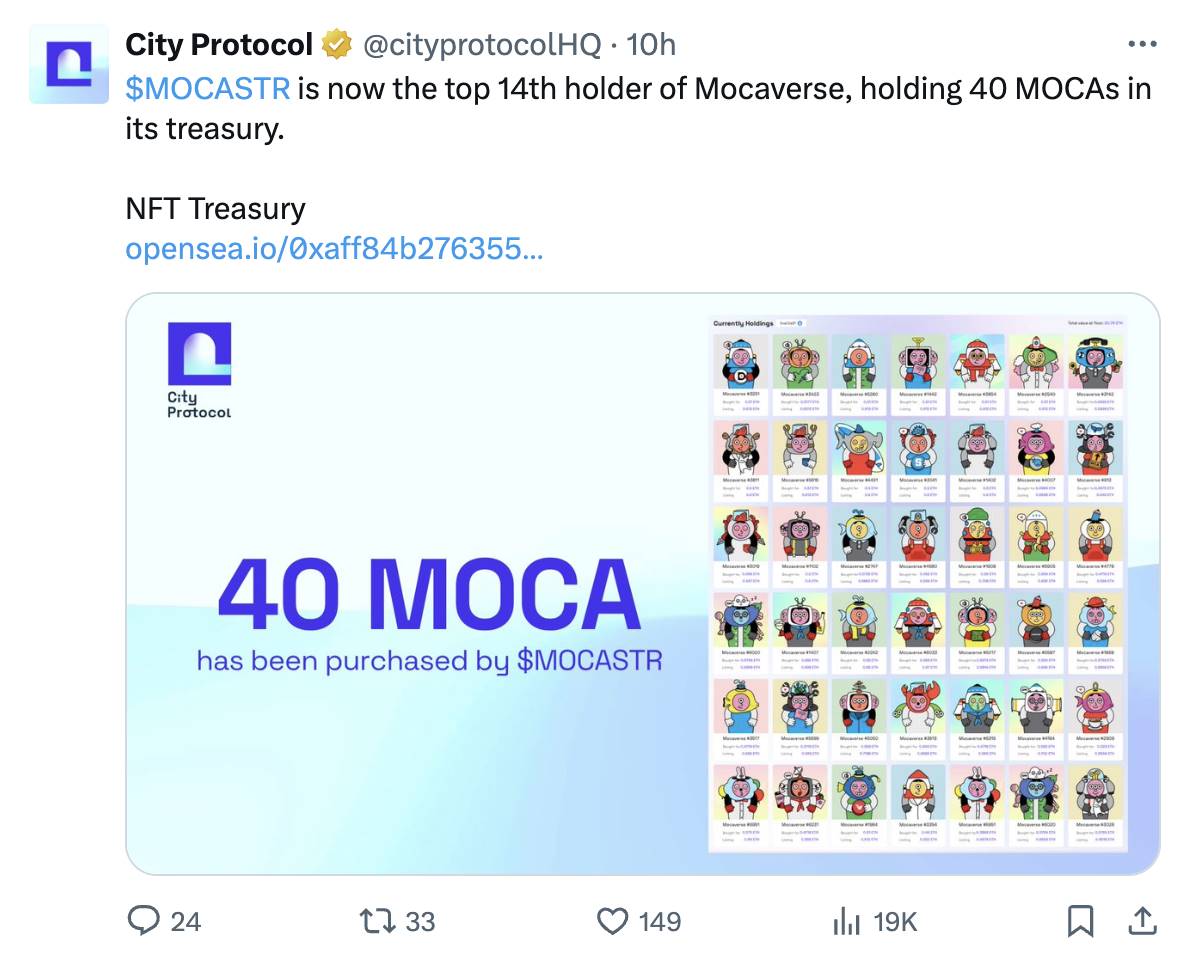The significance of MOCASTR lies not in its current price, but in its first-time establishment of a "treasury strategy" for NFTs.

1. A New Turning Point for Web3: From Narrative to Asset Management
If the keywords for Web3 in 2021 were "innovation," in 2022 "speculation," and in 2023 "adjustment," then 2025 clearly belongs to "assetization." Whether it is the on-chain transformation of real-world assets (RWA) or the refinancing of blue-chip NFTs, the market, after undergoing a cycle of cleansing, returns to the most fundamental logic—how to create sustainable income on-chain.
At this turning point, Animoca Brands' ecosystem, Mocaverse, and City Protocol launched a highly structurally innovative joint project: $MOCASTR (Moca Strategy Token).
This is a mechanism token centered around the high-value intellectual property (IP) assets of Mocaverse, driven by an on-chain strategy treasury (Tokenised Strategy) to facilitate a revenue cycle. It is not merely a "coin," but more like a digital asset strategy engine that can operate actively and appreciate perpetually.
City Protocol has set an ambitious definition for this experiment: "To bring cultural IP into a programmable financial physical cycle." From an investment perspective, this is an attempt at structural innovation in the NFT market.
2. Mechanism Analysis: An On-Chain Strategy Entity of "Self-Compounding"
City Protocol's IP Strategy module is an on-chain strategy system (Tokenised Strategy Module) specifically designed for the IP ecosystem. The core logic of this module is very straightforward: it drives community funds into the treasury through token economics, and then supports the long-term value construction of IP through on-chain strategies. In other words, it is not a "passive asset pool," but a tokenized IP strategy execution layer.
MOCASTR is the first token of this module and the starting point of all flywheels.
The design of MOCASTR can be summarized in three stages: fee injection, treasury strategy execution, and profit reinvestment.
Each transaction generates a 2.5% fee, of which 80% is automatically injected into the treasury. The treasury continuously monitors the market conditions of Mocaverse NFTs through on-chain data interfaces, including floor prices, transaction depth, and volatility ranges. When the system detects an undervalued range, the IP Strategy will execute NFT buybacks; subsequently, these assets will be re-listed for sale at a premium of about 1.2 times the floor price.
After completing a "buy low, sell high" loop, the profits generated will be divided into two parts: one part will be used to buy back and burn $MOCASTR tokens, creating a deflationary effect; the other part will remain in the treasury, further expanding its operational space and driving the next cycle.
Thus, the entire system forms a self-driven closed loop: Fee injection → NFT buyback → Premium sale → Profit return → Token burn → Treasury expansion. This logic is similar to automated market makers (AMM), except that the underlying assets have shifted from trading pairs to value conversion between NFTs and tokens.

The core innovation lies in the fact that users do not need to directly participate in NFT transactions to share in the overall revenue of the Mocaverse ecosystem by holding $MOCASTR. NFTs evolve from static collectibles into income-generating assets, while tokens become the vehicle for sharing this value generation process.
This structure is very similar to MicroStrategy's "holding coin flywheel," but what MOCASTR constructs is not a company-level financial cycle, but a collective treasury model at the token level. It transforms "IP market value management" from the actions of a single brand into a shareable, participatory, and tokenizable on-chain logic.
3. Flywheel Expansion: The Resonance Mechanism of Tokens, Treasuries, IP, and Markets
The MOCASTR flywheel is a four-layer cyclical system:
Token Layer: All transaction-generated fees continuously inject funds into the treasury, forming the basic fuel.
Treasury Layer: City Protocol's IP strategy takes over the funds, transparently executing IP-related strategic actions on-chain, such as maintaining the market depth of Mocaverse NFTs, supporting linked activities, or ecological proposals.
IP Layer: Mocaverse enhances its influence through brands, communities, and cross-ecosystem collaborations, increasing the expected value of IP, making the market effects of treasury fund outputs amplifiable.
Market Layer: As the value of Mocaverse grows, the market recognition of $MOCASTR simultaneously increases, new liquidity and trading frequency rise, feeding back into transaction fees, further strengthening the treasury.
The essence of this cycle is to drive IP appreciation through market fluctuations in reverse. The treasury acts as an energy storage device; the token serves as the drive shaft; the IP is the core of growth; and the market is the feedback mechanism. The four elements interlock, forming a transparent and self-driven growth system.
In the past NFT market, IP value often remained in the "collectible era"—holding, appreciating, and socializing;
In the MOCASTR model, IP begins to enter the "treasury era"—being managed, utilized, and compounded.
4. Mocaverse and City Protocol: A Combination of Narrative and Execution
$MOCASTR officially launched on the Solana mainnet on October 29. Due to its buyback strategy and high-speed execution architecture, the project exhibited unexpectedly strong market performance in a short time. Within 48 hours of launch, the treasury completed the buyback of 40 Mocaverse NFTs, driving the floor price of the Mocaverse series up by about 15%.

At the same time, the first round of strategy cycles demonstrated an annualized return of about 20%, providing direct cash flow support for the token's value. The liquidity pools of Raydium and Jupiter gained over $300,000 in initial depth on the day of launch, with the project’s market capitalization reaching between $2 million and $3 million within hours.
Mocaverse is the flagship identity and cultural ecosystem of Animoca Brands, integrating over 540 projects and 700 million on-chain wallets since 2023. The 8,888 Moca NFTs have built four major archetype communities: Dreamers, Builders, Angels, and Connectors, which not only have cultural symbolic significance but also possess governance, reputation, and points systems.
These NFTs reflect Animoca's long-term layout in social, gaming, and identity layers, providing a solid asset and community foundation for MOCASTR.
After receiving investments from institutions such as Jump Crypto, Dragonfly, and CMT Digital in 2024, City Protocol has been deeply engaged in the field of "on-chain IP financialization," proposing the DAT framework (Digital Asset Treasury) to support sustainable asset growth. With its treasury system, the ecological energy of Mocaverse can be translated into more direct capital flow and market momentum.
The launch of MOCASTR marks the first formal resonance between Mocaverse and City Protocol—culture and finance, narrative and execution, IP and capital, truly combined in a smart contract.
The two have formed a clear division of labor: Mocaverse is responsible for the asset body and cultural moat, while City Protocol builds the algorithmic engine and capital management foundation. In this model, MOCASTR becomes the bridge between the two and a template for future on-chain IP financialization.
This combination allows the market to see a new ecological structure:
IP strategies are no longer abstract but become a tradable and governable token entity.
Interestingly, Animoca's founder Yat Siu personally purchased Mocaverse NFTs that were bought back and resold by City Protocol's treasury after the project launch. The market generally views this as not merely a symbolic action but a validation signal of the mechanism itself: the consensus between IP parties and DeFi protocols is forming a new type of "liquidity contract."

5. Why is this a model needed by the market?
The NFT market has entered a long "post-heat period." The price fluctuations of blue-chip IPs have slowed, new capital is lacking, and attempts to integrate DeFi have frequently failed. The biggest problem in the entire ecosystem is not a lack of narrative, but a lack of structural momentum.
After the launch of MOCASTR at the end of October, it quickly became the focus of on-chain attention. Within 48 hours, the treasury executed multiple operations, significantly enhancing the floor price and transaction depth of Mocaverse NFTs. Meanwhile, Animoca founder Yat Siu's community participation behavior provided a strong external trust signal for the flywheel.
More notably, it not only brought numerical growth but also led to a concentrated return of market sentiment.
A large number of crypto KOLs, NFT investors, and on-chain researchers began discussing the MOCASTR mechanism on social media—how it allows NFTs to possess "compounding financial logic," and how it enables cultural assets to resonate with DeFi growth models for the first time.
This phenomenon acts as a trigger point, causing the long-silent NFT investment circle to look up again: shifting focus from surface-level art and trading to how to increase the revenue structure and endogenous financial cycle for IP.
What City Protocol's IP Strategy module provides is precisely this momentum—not merely financial operations, but a sustainable growth structure.
It allows IP projects to no longer rely on one-time issuance income but to gain continuous support through strategy treasuries;
It allows token holders to be not just speculators, but participants and beneficiaries of IP growth.
The long-term potential of this structure lies in:
● IP value has brand and cultural limits;
● The treasury provides cash flow and market support;
● Tokens connect users and mechanisms, making the community a source of growth;
● The entire system forms a continuous symbiosis of "culture × capital."
The success of MOCASTR means that the NFT market has, for the first time, a "strategy-based growth engine," rather than just an "emotion-based investment field."

6. Future Outlook: The "Programmability" of IP Assets
City Protocol has hinted that this collaboration is just the starting point of a "series of strategies." The City Protocol team is currently still focused on refining the IP Strategy. Future directions will revolve around optimizing the execution parameters of the strategy treasury, enhancing cross-IP collaboration capabilities, and introducing more on-chain governance participants.
But it is certain that MOCASTR has already proven:
IP can have treasury management logic similar to corporate assets;
Cultural assets can enter the on-chain capital cycle through tokenization;
The market can generate new revenue and consensus in the process of participating in this cycle.
Regardless of which types of assets the IP Strategy module expands to next, its "tokenized strategy treasury" model has become the most likely new narrative in the NFT market following GameFi and RWA.
8. Conclusion: The True Value of IP Returns to Cash Flow
The emergence of MOCASTR may signify an important turning point in the NFT economic model.
For the past two years, the "value controversy" in the NFT market has always revolved around whether it possesses intrinsic revenue; now, MOCASTR provides a verifiable answer.
The NFT micro-strategy model represented by MOCASTR allows cultural assets to possess financial operational logic for the first time;
City Protocol's IP Strategy module systematizes and replicates this logic—this is a key step for the NFT market to emerge from its low tide and reshape growth.
As cultural assets, IP is being written into on-chain economics. Tokens are not just circulation tools but also governance units and value levers. When the treasury can generate cash flow, IP can grow, and tokens can provide feedback, this flywheel will continue to turn.
The significance of MOCASTR lies not in its current price, but in its first-time establishment of a "treasury strategy" for NFTs. This may very well be the starting point for Web3 cultural assets to move towards autonomy and financial sustainability.
For Mocaverse, this means that the long-term value of its ecosystem is quantified and amplified; for the DeFi world, it provides a brand new strategic template—IP-driven, self-circulating revenue, and transparent treasury execution.
When holders are no longer just collectors, but shareholders of the treasury;
When animated characters and story worlds can bring stable cash flow;
Then the door to the "cultural capital market" may truly be opening in a cryptographic way.
Project Information
● City Protocol Official Website: https://cityprotocol.co/ipstrategy/token?id=7
● City Protocol Twitter: @cityprotocolHQ
● Moca Strategy Twitter: @Moca_Network
免责声明:本文章仅代表作者个人观点,不代表本平台的立场和观点。本文章仅供信息分享,不构成对任何人的任何投资建议。用户与作者之间的任何争议,与本平台无关。如网页中刊载的文章或图片涉及侵权,请提供相关的权利证明和身份证明发送邮件到support@aicoin.com,本平台相关工作人员将会进行核查。




